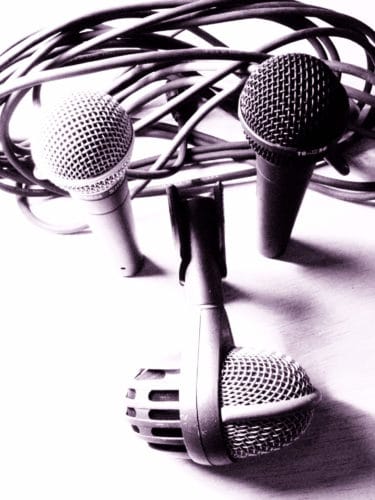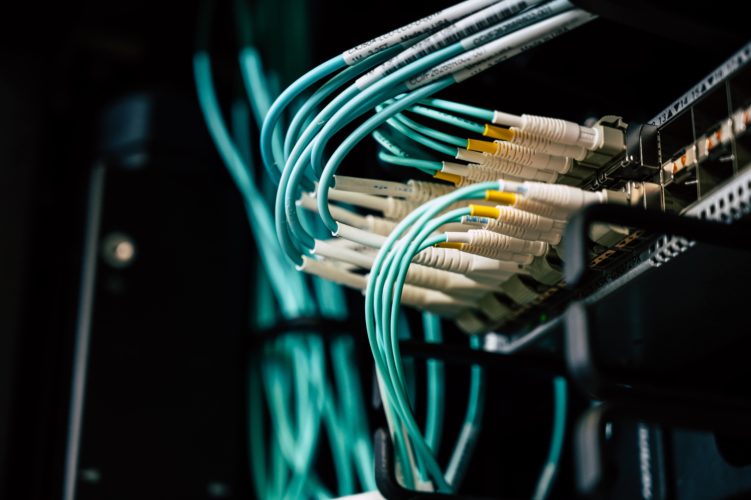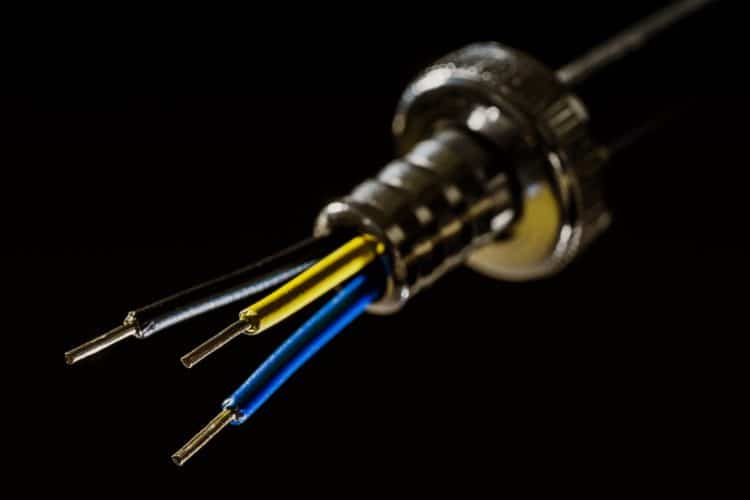Why is having proper audio cables important?
Imagine this. You’re playing a gig. You’re rocking out on your guitar.
Then, to your horror, a crackling noise comes through the speakers.
The sound man scrambles. Everyone in the crowd makes a sour face.
Your guitar cable has gone bad!
Most people assume that a cable is a cable.
But nothing could be further from the truth.
In this article, you will learn the differences between audio cables in different price points, and why you may want to choose good cables the first time.
The importance of good cables is nothing to take lightly!
But first things first, you need to choose the right cable for your project.
Is This The Right Cable For My Microphone?

With all the different audio cables that are out there, choosing the right one for your specific need is crucial.
Does the material matter? Do the conductors matter? Do you need to search for the proper voltage? How do you find cables that will actually stay connected? Is copper wire really important, or are any conductors alright if you buy good wires with proper shielding material?
Of course, all of these things matter. These are all great questions. But actually, shopping for the perfect wires for your audio-cable needs is an easy process.
There are all kinds of cables out there, and you need to know the right one to buy for your instrument or microphone.
In most cases, shielding will take care of itself as long as you buy wires that are a good fit for what you plan to keep them connected to.
A google search can be helpful when choosing the right cable. You can also utilize the user guide of your device, or look up the specs of your mic/instrument on the internet.
What Is A Microphone Cable?
For the most part, the proper cables to use for microphones are either going to be XLR or USB, depending on what type of mic you’ve purchased.
They are, for all intents and purposes, audio cables with specific types of connectors on them.
The importance of good wire cables cannot be overstated. But it is also important that you understand the good points of what makes a wire, or wires, the best choice for your needs.
(Looking for an awesome live vocal mic? Check out our list of the 14 Best Live Vocal Mics here!)
What Is An Audio Cable?
An audio cable is a cable used to transfer the analog or digital signals from an audio source to an amplifier or powered speaker.
But what type of cable are you going to need?
Here is a basic guideline to help you understand that.
The Common Types Of Cables, And What They Are

It is important to know the differences of these cables before purchasing them, because each one has a specific purpose.
Instrument Cables are small, shielded wires that allow high frequencies of volume to flow through.
XLR cables could function as instrument cables in some cases… though most instruments (basses, guitars, etc.) would utilize ¼ inch instrument cables.
Instrument cables are multiple conductor cables that convey low energy electrical signals used for monitoring or controlling the electrical power systems and their associated processes.
In layman’s terms… they are used to connect instruments to amplifiers, preamps, or mixing boards!
Patch Cables are what you use to connect your electronic devices to one-another. They are, essentially, tiny instrument cables.
You would, of course, use patch cables to connect your guitar foot pedals together, or to connect your effects rack to your amplifier, etc.
Microphone Cables are usually going to be either XLR cables or USB cables. XLR cables have three pins and a circular connector, while USB cables literally have USB connectors on both ends.
XLR itself stands for external line return, and they contain one male and one female end. The male end contains three prongs, and the female end contains three receptors that correspond with the prongs on the male end.
Almost always, the female end is the one that you would connect to the microphone… because the majority of microphones, of course, have male prongs.
USB stands for Universal Serial Bus, an industry standard for short-distance digital data communications.
This means these conductors can pass along sound waves. A USB uses a different port than the XLR. A USB port is a standard cable connection interface for personal computers and consumer electronics devices.
A Speaker Cable is the wire used for the electrical connections between speakers and amplifier sources.
There are three key electrical properties for speaker cables.
There are, as a general rule, two different types of speaker cables.
There are speakon cables, and ¼ inch cables.
Some older-school gear also uses what is called a ‘banana plug.’ This is a plug with two prongs that plugs into the amplifier. Usually, banana plug cables will have a banana plug on one end, and a quarter-inch adapter on the other.
Speaker cables cannot be used as instrument cables, though you usually can use instrument cables as speaker cables.
Speaker cables are shielded differently, which makes them ineffective as instrument cables.
Of course, Power Cables are different altogether. For the most part, the ‘power cable’ is different from the ‘instrument cable,’ though almost any cable with copper or any other conductor in it can carry a current. Power cords power your electronic devices. They are not designed to carry sound.
Now that you know the most common audio cables, let’s move on to talk about why a quality cable is a better option, as opposed to the cheaper ones.
The Importance Of Quality

When purchasing cables for literally anything, it is always important to really check into the product.
Cheap cables can easily fray, suffer damage, or stop working altogether if something goes really wrong.
Not all cheap cables are bad… but there are more than a few examples for why quality cables can be a better fit than cheap ones.
The first example would be simply the quality of the materials. If you have a live performance, the cables tend to get stepped on, rolled too tightly, and sometimes even get water damage (spilled beer is a real problem at some rock shows).
Now, the cheaper cables in this example would not be good because of the lack of higher-quality materials being used.
To a certain point, a cable with the proper connectors is absolutely that… a cable with the proper connectors.
As long as audio is moving through the XLR or ¼ inch cable, and nothing is broken, you will probably end up with sound that is pretty reasonably decent, regardless of whether you are using the high-dollar cable or the cheaper version.
But how well that cable resists the stress it is put under during use is absolutely a different story.
You need your cables to be able to resist the rigors of whatever you plan to put them through.
Obviously, if you only plan to hook the cable up to your mic in your studio, and never move it… you would probably be able to get away with the cheaper cable, because the connectors are what tend to break the fastest.
(Looking for an awesome studio microphone? Check out our list of the 18 Best Recording Microphones here!)
And connectors see far more stress and strain when they are plugged in and unplugged again than when they are left stationary and alone.
This is why the touring musicians tend to spend more money on the higher-quality cables… because setting up and tearing down after a set is the greatest potential source of stress on the cable connectors.
Every time the cable is plugged in, and then unplugged again, stress is being applied to the connectors.
A quality cable can literally last a lifetime of strain, while the cheap cables you buy can sometimes go bad even after just one use, if something inside of them breaks.
(I’ve seen bands come in with an 8-pack of quarter inch cables they bought for $25 on Ebay, only to ruin 6 of them over the course of the night!)
Lower quality solder joints, connectors that do not protect the internal components as well, rubber shielding that does not hug the wiring as closely… these are all factors to take into account.
This of course leads to the question of “how does the difference in quality fit into my budget?”
Why You Should Invest In A More Expensive Wire

Another potential source of strain for any cable is storage.
If you let the audio cords get all tangled up, and then pull them apart every time you go to plug in your instrument… you are far more likely to run into problems.
To keep this from happening, make sure to roll them up gently, secure the rolls with velcro strips, and keep them organized when you stow them away.
Allowing your cables to get all tangled up will significantly reduce their lifespan.
Some people believe that shielding will protect the wires from damage… but this isn’t really true. It is one of the features to look for, but it is more designed to prevent power interference than actual physical damage.
Where Should You Store Your Cables?
For best results, store your cables in a waterproof container that will also shield them from sunlight.
Cables usually have a lot of rubber components… and this rubber can get soft in direct sunlight, thereby increasing the odds of the cords suffering damage.
Can The Temperature During Storage Affect The Cables?
Just like with most electrical equipment, extreme heat or cold can cause the cables to stop working.
Heat can cause melting of the outer layer of the cables, which can stick them together.
This would be a hassle to undo, and could potentially tear open each cable.
Severe cold weather can also cause harm to your cables. Freezing can lead to cracks in the cables, which could cause sound issues and lead to further damage.
You’re All Set!

This all may seem like a lot to process.
But it’s actually really simple.
Just take stock of what type of cable you need, what you plan to do with it, and how often you plan to use it.
Obviously, practice cables can also be purchased as a less-expensive option… and you can save the expensive cables for live shows.
Whatever the project may be, good cables will always play a part.
Choosing the right cable may not be as interesting or as fun as choosing the right microphone or guitar. But it is a vital step that will help you as you create and pursue excellence in your craft.
At the end of the day, you need the right tools for the right job.
And if your job has anything to do with audio, then quality cables are an essential ingredient to success.
